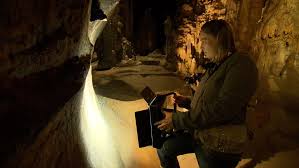National Geographic funds UVic paleoanthropologist to solve 40,000-year-old mystery
Source: CBC News
Victoria cave researcher, Genevieve von Petzinger, is suddenly in a pretty good position to find what she calls the Holy Grail of her field.
The University of Victoria paleoanthropologist, who specializes in European cave art, has been awarded a National Geographic grant to test genetic material found in cave wall paint in Spain to try to find out who forgot to sign their work at least 40,000 years ago.
A DNA test, which would reveal genetic mutations due to evolution, could help pinpoint the time period a painting was made and may help determine if the art was actually the handiwork of humans or Neanderthals — who lived about 130,000 to 40,000 years ago.
“‘It would just be so fascinating to see the identity,” said Petzinger Tuesday on On The Island. “The million dollar question is, did Neanderthals paint?”
And there is already some indication, according to von Petzinger, thatthis extinct species was, in fact, artistic.

Von Petzinger said, a few years ago, some of her colleagues tested samples of minerals they found covering cave drawings and determined the minerals to be 65,000 years old, which von Petzinger said indicated the art underneath was older and, therefore, drawn by Neanderthals.
But, she said, this dating method was hotly debated by others in the field.
“It was quite the big drama going back and forth,” said von Petzinger, who then thought maybe genetic testing could be a way to get a definitive answer.
Genetic testing can even pinpoint the artist’s gender and, said von Petzinger, possibly lead to finding a living descendent.
“This would be a world first,” she said, her voice brimming with excitement.

Von Petzinger said she is incredibly grateful to colleagues, the Spanish government and National Geographic for being willing to believe in her “crazy idea.”
But it’s not without precedent.
She said other researchers have had success testing genetic material found in dirt on the floor of caves in Croatia and she is “cautiously optimistic” she will have similar success with paint substances.
There is a bit of a snag though.
The money is in place, and all the players are on board, but it could be awhile before von Petzinger can board a plane.

She said her tentative plan is to be back in the caves, where she previously spent a significant amount of time doing field work, by summer 2021.
The COVID-19 pandemic has thrown a wrench into field work for many academics, but von Petzinger said she is staying connected with colleagues online and it is a great time for scientists to slog through statistical analysis work they might as well get done while they can’t get out.
And it could be because of her line of work, but von Petzinger is cautiously optimistic about the current state of the world as well.
“This pandemic is certainly a pretty scary thing, but our ancestors have survived some pretty scary things themselves,” she said. “Our species is very resilient.”
Source: CBC News

































Leave a Comment
You must be logged in to post a comment.